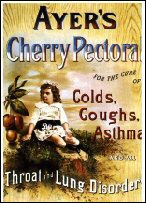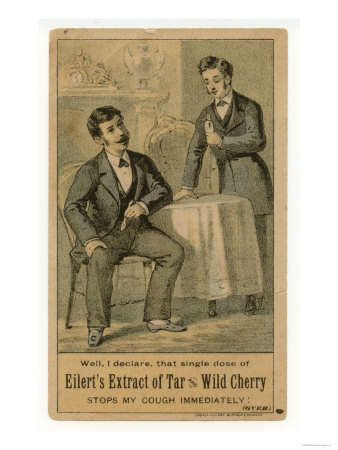
Prunus serotina (Ehrh.)
 Synonyms: Virginian prune, black cherry, black
choke, choke cherry, rum cherry
Synonyms: Virginian prune, black cherry, black
choke, choke cherry, rum cherry
Order: Rosaceae
Description: Prunus is a large tree, up to 30m tall, and is widely distributed in woods throughout North America, especially in the Northern and Central states. It produces alternate stiff oblong or ovate leaves with serrated margins and small white flowers growing in lateral racemes. The bark is rough and nearly black on older trunks, but that used is younger, smooth, glossy and reddish brown with white lenticels and underlying greenish-brown cortex. The fruit is a nearly spherical, purple-black drupe, around 1.5cm in diameter, ripening in late summer and autumn.
Parts used: dried bark
Collection: from young plants in the autumn when it has its highest prussic acid content.. The outer bark is stripped off and the inner bark dried in the shade. It should be protected from light.
Constituents: cyanogenic glycosides including prunasin; volatile oil, benzaldehyde, coumarins, benzoic acid, gallitannins, resin, an enzyme (prunase).
 Actions: antitussive, expectorant, mild
sedative, astringent, digestive bitter, tonic, pectoral, stomachic
Actions: antitussive, expectorant, mild
sedative, astringent, digestive bitter, tonic, pectoral, stomachic
Indications: irritable and persistent cough of bronchitis, pertussis, cough due to increased irritability of respiratory mucosa. Nervous dyspepsia.
Therapeutics and Pharmacology: Prunus is an important cough remedy. The cyanogenic glycosides are hydrolysed in the body to glucose, benzaldehyde and hyanocyanic acid, otherwise known as prussic acid. Prussic acid is rapidly excreted via the lungs where it first increases respiration and then sedates the sensory nerves which provoke the cough reflex. Due to its powerful sedative action, it is used primarily in the treatment of irritating and persistent coughs when increasing expectoration is inappropriate, and thus has a role in the treatment of bronchitis and whooping cough and in the racking cough of debility or convalescence. It can be combined with other herbs to control asthma. Both the cyanogenic glycosides and volatile oil help to improve the digestion, and Prunus may be used as a bitter where digestion is sluggish. The cold infusion of the bark may be used as a wash in eye inflammation and as an astringent in diarrhoea.
Combinations: Prunus may be combined with Tussilago and Marrubium in pertussis or with Lactuca, Verbascum, Inula and Humulus in nervous cough. It may be combined with Althaea root, Filipendula and Chamaemelum in nervous dyspepsia.
Caution: Prunus cause drowsiness. Cyanogenic glycosides are moderately toxic, producing cyanic acid on hydrolysis, and should not be taken to excess. The leaves have poisoned cattle.
Preparation and Dosage: (thrice daily)
Regulatory status GSL
Powdered bark: 0.5-2g or by infusion
Tincture BPC: 2-4ml
Liquid extract: 1:1 in 25% alcohol 1-2ml
Syrup BPC 2.5-10ml.
Additional Comments: The Native Americans had many uses for Wild Cherry bark including a tea made from the inner bark to ease labour pains, diarrhoea and lung problems. Chinese physicians prescribe Prunus yedoensis for coughs.
Bibliography
BHMA 1983 British Herbal Pharmacopoeia, BHMA, Bournemouth.
Grieve, M. 1931 A Modern Herbal, (ed. C.F. Leyel 1985), London.
Hoffmann, D. 1990 The New Holistic Herbal, Second Edition, Element, Shaftesbury.
Lust, J. 1990 The Herb Book, Bantam, London.
Mabey, R. (ed.) 1991 The Complete New Herbal, Penguin, London.
Mills, S.Y. 1993 The Essential Book of Herbal Medicine, Penguin, London (First published in 1991 as Out of the Earth, Arkana)
Mills, S.Y. 1993 The A-Z of Modern Herbalism, Diamond Books, London.
Ody, P. 1993 The Herb Society's Complete Medicinal Herbal, Dorling Kindersley, London.
Polunin, M. and Robbins, C. 1992 The Natural Pharmacy, Dorling Kindersley, London.
Wren, R.C. 1988 Potter's New Cyclopaedia of Botanical Drugs and Preparations, C.W.Daniel, Saffron Walden.










